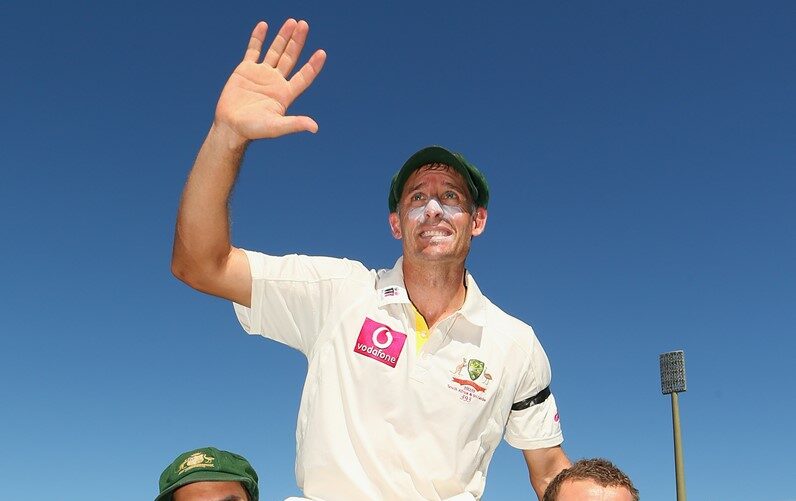Spot on: Australia’s Michael Hussey is chaired off by Mitchell Johnson and Peter Siddle (photo: Getty Images)
By Garfield Robinson
One Tour Too Many is the title of a chapter in David Foot’s Wally Hammond: The Reasons Why. Therein the author argues that the man who Sir Leonard Hutton described as “the most perfect batsman I ever saw, more enjoyable to watch than Sir Don”, might have made a misjudgment when he embarked on his last tour to Australia in the winter of 1946-47.
“Hammond was now 43,” Foot wrote, “His eyes were tired and his teeth stained from nicotine. Some of the natural exuberances had gone from his exquisite strokeplay, even though he had just topped the first-class averages again (84.90) and at times batted quite beautifully in limited appearances.”
Hammond’s Test average is 58.45. But he ended that tour with a total of 168 runs in eight innings, averaging a paltry 21.00, and looked nothing like the master batsman the Australians had witnessed on prior visits. In short: Wally Hammond was no longer Wally Hammond.
By 1980, Muhammad Ali was no longer Ali. “The Greatest,” now 38, was about to challenge his friend, one-time sparring partner and WBC heavyweight champion, Larry Holmes. To anyone paying close attention, and even to casual onlookers, this was not the Ali of years past. This was not the “float like a butterfly, sting like a bee” Ali. The fast-dancing, fast-talking, supple, athlete was replaced by one who slurred his words, was slightly labouring in his movements.
Whether admitting it or not, those around him noticed. They saw the transformation, saw Ali was slowing, but felt some compulsion to indulge the great man. It wasn’t as if he’d not been doubted before – few thought he could’ve beaten Sonny Liston, and later, George Foreman – but even against the most foreboding odds he somehow found a way. They were sure he’d find a way again.
Ali himself had no doubt. He still felt he could dance and will himself to victory; that he could outsmart and out manoeuvre any boxer. His mind told him he was the same Ali who trapped Foreman with the “rope-a-dope”; the same Ali who endured those punishing battles with Joe Frazier and Ken Norton; the Ali who was one of the best boxers of all time.
He was wrong. That Ali was no more. Holmes beat him badly. And yet amid all the pounding, he refused to go down, even as Holmes looked back at the referee urging him to stop the fight. It took those in his corner, seeing the fearful beating he was suffering and fearing for his wellbeing, to throw in the towel.
There is really nothing unusual about the story of Ali and Hammond carrying on too long. History is replete with instances of great performers failing to recognise the diminution of their skills. They remain champions in their minds even after their finest days are past.
As with every other sport, cricketers have had to grapple with the question of when to walk away — that is if the decision is not made for them by selectors. Determining the correct time can be tricky and is often the cause of much discussion and disagreement in and around the team.
We often hear that the time to go is when you’re at the top of your game. But it’s difficult to see the wisdom in that. It is when you’re at the height of your powers that you should remain in the game and build your legacy. The time to leave is when you are declining but are still competent. Unlike Ali, you don’t want to get to the point where too much deterioration has occurred and you are at, or indeed, well past the point of becoming something of an embarrassment.
The right timing can be problematic. We have seen great players who waited too long. In a way, this is understandable. It must be difficult to leave behind something you excelled at and dedicated your life to. Additionally, top players develop large numbers of followers, some of whom become sycophants, stroking their idols’ egos, strengthening the voice in their heads telling them they’re still great despite much evidence to the contrary.
Elite athletes often operate in a bubble of back-slapping, and positive reinforcement can lift performance. But it also contributes to a refusal to accept a reality apparent to almost everyone else.
Some prefer to leave while their spot is not in question rather than place their destiny in the hands of the selectors. Michael Hussey, to everyone’s surprise, announced his retirement from Test cricket shortly before the Sydney encounter during Sri Lanka’s 2012-13 visit. He had scored a hundred in the first game of the three-Test series in Hobart so he was in no danger of losing his place. Yet he was also aware that at 37 he was getting on and the selectors would no doubt be looking to the future.
In My Story, his autobiography, Michael Clarke, Hussey’s then captain, takes us back to Hussey’s decision, referencing the previous departure of another stalwart, Ricky Ponting. “Unlike Punter, Huss is under no immediate pressure to score runs. He’s had another solid summer. But he is 37, six months younger than Punter, and dreads the pressure that bubbles up every time a player of his age has a couple of failures. He’s sick of that feeling: Are they going to drop me? Why is the Press talking about my position again? We all know what this feels like. It’s a nasty, nasty feeling.”
In contrast, it could be argued that someone like West Indies batsman Shiv Chanderpaul left it too late and suffered the indignity of being dropped, even after pleading that he wanted a few more games so he could receive a proper send-off. It was apparent that he was no longer the player he was and ought to have risked leaving too early rather than make himself so vulnerable.
It is a subjective exercise determining who might have stayed on too long, who left too early, or who got out at the right time. Did Tendulkar, for example, allow his abilities to fade too much before he left the scene? What about Sangakarra? After he retired from international cricket he showed that, had he been minded, he could have stayed on a bit longer.

Undoubtedly, Bradman could have continued scoring century after century a few more years. In his last series in England in 1948 he averaged 72.57 and was still the best in the world. Michael Holding retired at 33. His countryman Courtney Walsh played until he was 38. Could “Whispering Death” have granted us the pleasure of viewing him in action a few more years?
In the end, time conquers all athletes. It depends of the genre but, generally, sportsmen are at their peak from their mid-20s to early 30s. Thereafter reactions slow; eyesight becomes less sharp; fast-twitch muscle fibres decrease; the body becomes less efficient in transporting oxygen, leading to less aerobic capacity; and the body takes more time to recover from exertion.
Sportsmen can rage all they want against its deleterious effects, but Father Time eventually knocks on every door and there is little choice except to let him in. It is then the athlete has to begin the process of deciding how much he will allow his skills to deteriorate before he calls it a day.
In the not too distant future, Pakistan batsmen Misbah-ul-Haq and Younis Khan will have to make these decisions. Both are great players who have served their country outstandingly well. But at 42 (which makes Misbah a freak of nature) and 39 respectively, both are at an age where their end in the game cannot be far off. Indeed, it is astonishing they have lasted this long and it will be a sad day for cricket whenever they decide to, or are forced to, say farewell.
Despite recent runs, neither could claim to be the players they were in their prime. Younis’ astonishing century at Sydney shows he is still a valuable member of the side, yet it will take only a brief barren period for his place in the team to be questioned.
At his and Misbah’s age a decline in productivity is seen as fatal, rather than dismissed as a temporary setback in form as it probably would have been ten years earlier. It will be interesting to observe the choices they make.
The decision to embark on an athletic career is normally made in a fit of excitement and expectation. Deciding when to go normally requires much more thought and reflection. It is one of the most difficult decisions the great player will have to make in his career and in his life.















